 W
WPhysalaemus is a large genus of leptodactylid frogs. These frogs, sometimes known as dwarf frogs or foam frogs, are found in South America. It is very similar to Leptodactylus, a close relative, and indeed the recently rescribed Leptodactylus lauramiriamae is in some aspects intermediate between them.
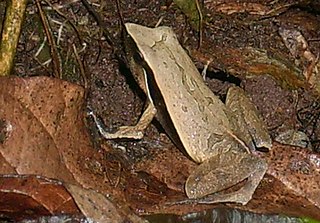 W
WPhysalaemus albonotatus is a species of frog in the family Leptodactylidae. It is found in Brazil, Paraguay, and Chacoan Argentina and Bolivia.
 W
WPhysalaemus atlanticus is a species of frog in the family Leptodactylidae. It is endemic to Brazil. Its natural habitats are subtropical or tropical moist lowland forests, freshwater marshes, and intermittent freshwater marshes.
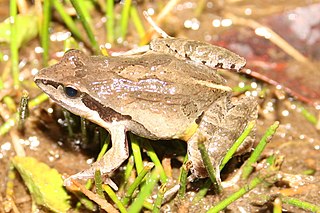 W
WPhysalaemus barrioi is a species of frog in the family Leptodactylidae. It is endemic to Serra do Bocaina in São Paulo state, Brazil. The specific name barrioi honors Avelino Barrio, a Spanish botanist and zoologist who lived in Argentina. However, the common name Bocaina dwarf frog has been proposed for it.
 W
WPhysalaemus biligonigerus is a species of frog in the family Leptodactylidae. It is found in Argentina, Bolivia, Brazil, Paraguay, and Uruguay. Its natural habitats are subtropical or tropical dry forests, temperate shrubland, subtropical or tropical dry shrubland, subtropical or tropical moist shrubland, temperate grassland, subtropical or tropical dry lowland grassland, subtropical or tropical seasonally wet or flooded lowland grassland, freshwater lakes, intermittent freshwater lakes, freshwater marshes, sandy shores, arable land, pastureland, plantations, rural gardens, urban areas, heavily degraded former forest, water storage areas, ponds, irrigated land, seasonally flooded agricultural land, and canals and ditches.
 W
WPhysalaemus caete is a species of frog in the family Leptodactylidae. It is endemic to Brazil. Its natural habitats are subtropical or tropical moist lowland forests and intermittent freshwater marshes. It is threatened by habitat loss.
 W
WPhysalaemus centralis is a species of frog in the family Leptodactylidae. It is found in Bolivia, Brazil, and Paraguay. Its natural habitats are moist savanna, subtropical or tropical moist shrubland, subtropical or tropical seasonally wet or flooded lowland grassland, freshwater marshes, and intermittent freshwater marshes. It is threatened by habitat loss.
 W
WPhysalaemus cicada is a species of frog in the family Leptodactylidae. It is endemic to Brazil. Its natural habitats are dry savanna, moist savanna, and intermittent freshwater marshes. It is threatened by habitat loss.
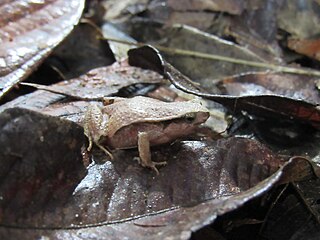 W
WPhysalaemus crombiei is a species of frog in the family Leptodactylidae. It is endemic to Brazil. Its natural habitats are subtropical or tropical moist lowland forests and intermittent freshwater marshes. It is threatened by habitat loss.
 W
WPhysalaemus cuvieri is a species of frog in the family Leptodactylidae. It is found in Argentina, Brazil, Paraguay, and possibly also Bolivia, Guyana, Uruguay, and Venezuela. Its natural habitats are subtropical or tropical moist lowland forests, moist savanna, subtropical or tropical dry lowland grassland, subtropical or tropical seasonally wet or flooded lowland grassland, intermittent freshwater lakes, intermittent freshwater marshes, arable land, pastureland, plantations, rural gardens, urban areas, heavily degraded former forest, ponds, irrigated land, seasonally flooded agricultural land, and canals and ditches. It is threatened by habitat loss.
 W
WPhysalaemus deimaticus is a species of frog in the family Leptodactylidae. It is endemic to Brazil and only known from its type locality in Jaboticatubas, Serra do Cipó, Minas Gerais. The specific name deimaticus is derived from Greek deimos fror "fear" and refers to the defensive display of this frog, probably aimed at scaring predators. Common names Jaboticatubas dwarf frog and frightening foam froglet have been coined for it.
 W
WPhysalaemus ephippifer is a species of frog in the family Leptodactylidae. It is found in central and eastern Brazilian Amazonia, the Guianas, and southern Venezuela. It might not occur in French Guiana.
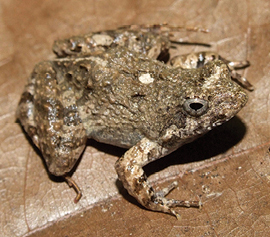 W
WPhysalaemus erikae is a species of frog in the family Leptodactylidae. It is endemic to eastern Brazil and currently known only from southern Bahia, although it is likely that its range extends into nearby areas in northeastern Minas Gerais and northern Espírito Santo with similar vegetation.
 W
WPhysalaemus fernandezae is a species of frog in the family Leptodactylidae. It is found in Argentina, Uruguay, and possibly Brazil. Its natural habitats are subtropical or tropical seasonally wet or flooded lowland grassland, intermittent freshwater marshes, and rocky areas. It is threatened by habitat loss.
 W
WPhysalaemus gracilis is a species of frog in the family Leptodactylidae. It is found in southern Brazil, Uruguay, and adjacent Argentina, and likely also in Paraguay. Its natural habitats are forest borders and Cerrado grasslands. It is an adaptable species that also occurs in heavily disturbed and polluted habitats. It breeds using foam nests in natural temporary pools. This abundant and widespread species is not facing major threats.
 W
WPhysalaemus henselii is a species of frog in the family Leptodactylidae. It is found in Argentina, Brazil, and Uruguay. Its natural habitats are subtropical or tropical seasonally wet or flooded lowland grassland, intermittent freshwater marshes, pastureland, rural gardens, and urban areas. It is threatened by habitat loss.
 W
WPhysalaemus insperatus is a species of frog in the family Leptodactylidae. It is endemic to southern Brazil and is only known from its type locality, Serra da Pedra Branca do Araraquara in Guaratuba, Paraná. The specific name insperatus means "unexpected" or "surprising" in Latin and alludes to the fortuitous finding of a new species among old museum specimens, originally identified as Physalaemus olfersii; taxonomically, it is part of the so-called Physalameus olfersii species group.
 W
WPhysalaemus kroyeri is a species of frog in the family Leptodactylidae. It is endemic to northeastern Brazil.
 W
WPhysalaemus lisei is a species of frog in the family Leptodactylidae. It is endemic to Brazil. Its natural habitats are subtropical or tropical moist lowland forests, moist savanna, and intermittent freshwater marshes. It is threatened by habitat loss.
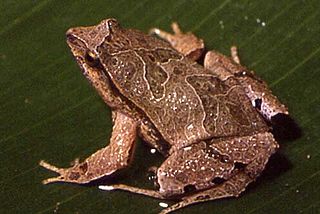 W
WPhysalaemus maculiventris is a species of frog in the family Leptodactylidae. It is endemic to Southeast and South Brazil and is known primarily from the Serra do Mar in Espírito Santo, Rio de Janeiro, São Paulo state, Paraná, and Santa Catarina states. Common name Mantagnes dwarf frog has been proposed for it.
 W
WPhysalaemus moreirae is a species of frog in the family Leptodactylidae. It is endemic to the Serra do Mar in the São Paulo state, Brazil.
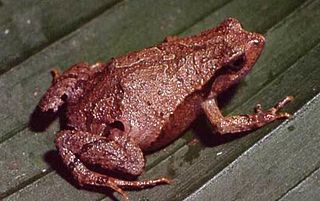 W
WPhysalaemus nanus is a species of frog in the family Leptodactylidae. It is endemic to Brazil. Its natural habitats are subtropical or tropical moist lowland forests, intermittent freshwater marshes, rural gardens, heavily degraded former forest, irrigated land, seasonally flooded agricultural land, and canals and ditches. It is threatened by habitat loss.
 W
WPhysalaemus nattereri is a frog native to central and southeastern Brazil and eastern Bolivia and Paraguay. It has two "false eyes" on its rear. The 3–4 cm frog lifts its rear end when threatened, startling predators. If a predator does not get fooled by the eyespots, and decides to move closer, the frog can produce an unpleasant secretion that comes from glands located in the eyespots. Similar display is known from Physalaemus deimaticus.
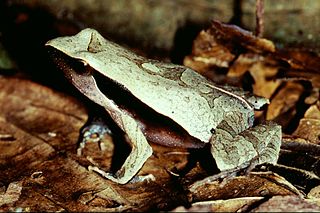 W
WPhysalaemus olfersii is a species of frog in the family Leptodactylidae. It is endemic to Brazil. Its natural habitats are subtropical or tropical moist lowland forests, subtropical or tropical moist montane forests, freshwater marshes, and intermittent freshwater marshes. It is threatened by habitat loss.
 W
WPhysalaemus riograndensis is a species of frog in the family Leptodactylidae. It is found in Argentina, Brazil, Paraguay, and Uruguay. Its natural habitats are subtropical or tropical seasonally wet or flooded lowland grassland, freshwater marshes, intermittent freshwater marshes, arable land, pastureland, ponds, seasonally flooded agricultural land, and canals and ditches.
 W
WPhysalaemus signifer is a species of frog in the family Leptodactylidae. It is endemic to Brazil. Its natural habitats are subtropical or tropical moist lowland forests, dry savanna, freshwater marshes, and intermittent freshwater marshes. It is threatened by habitat loss.
 W
WPhysalaemus spiniger is a species of frog in the family Leptodactylidae. It is endemic to Brazil. Its natural habitats are subtropical or tropical moist lowland forests, subtropical or tropical moist shrubland, intermittent freshwater lakes, and intermittent freshwater marshes. It is threatened by habitat loss.